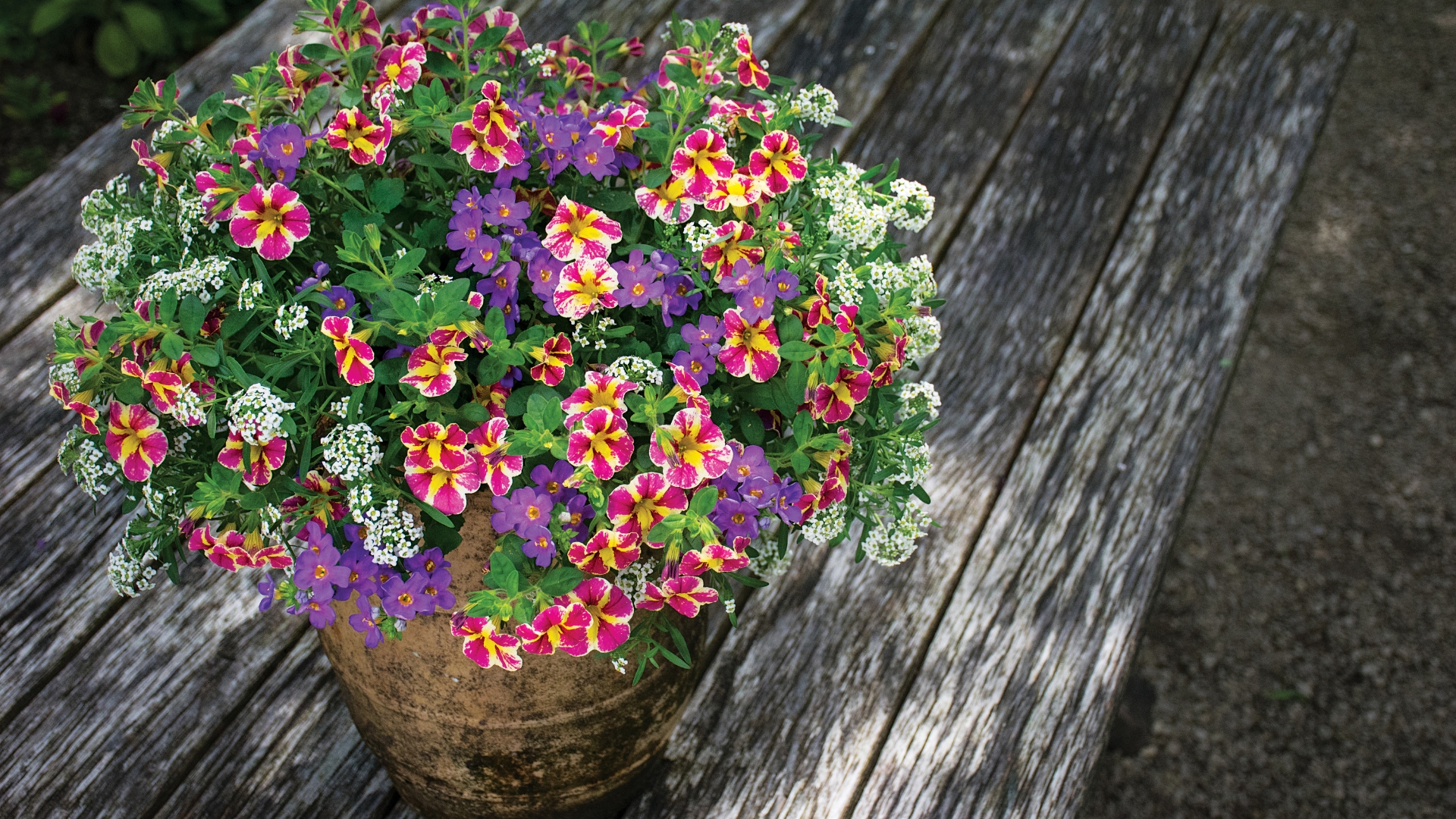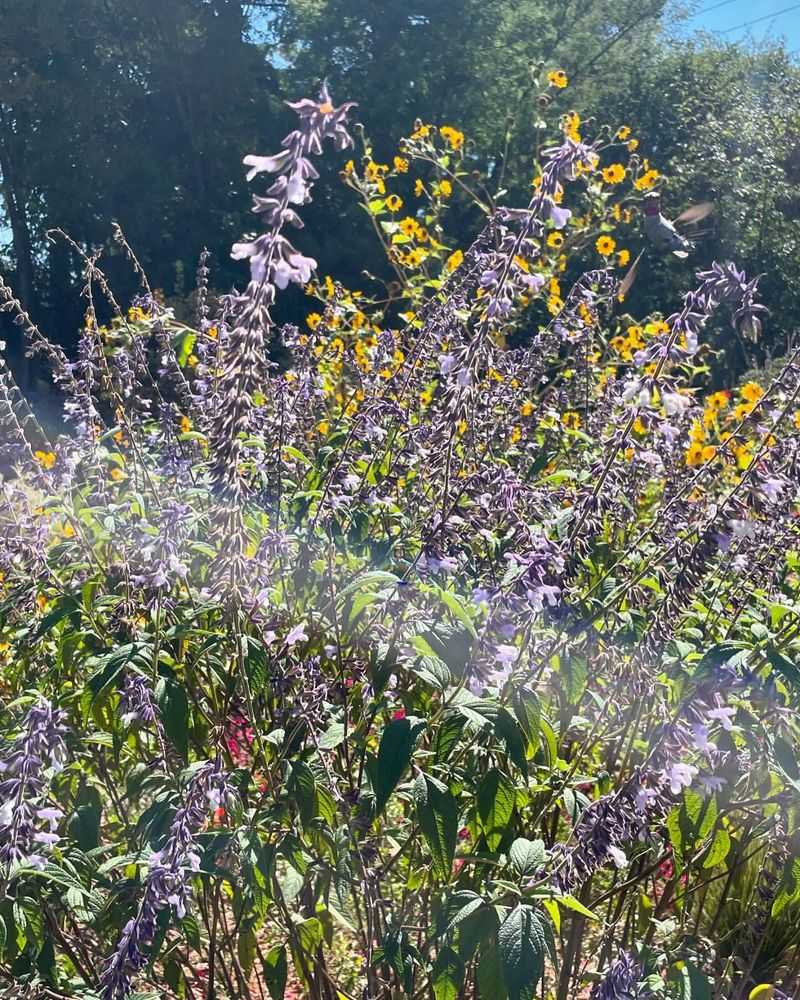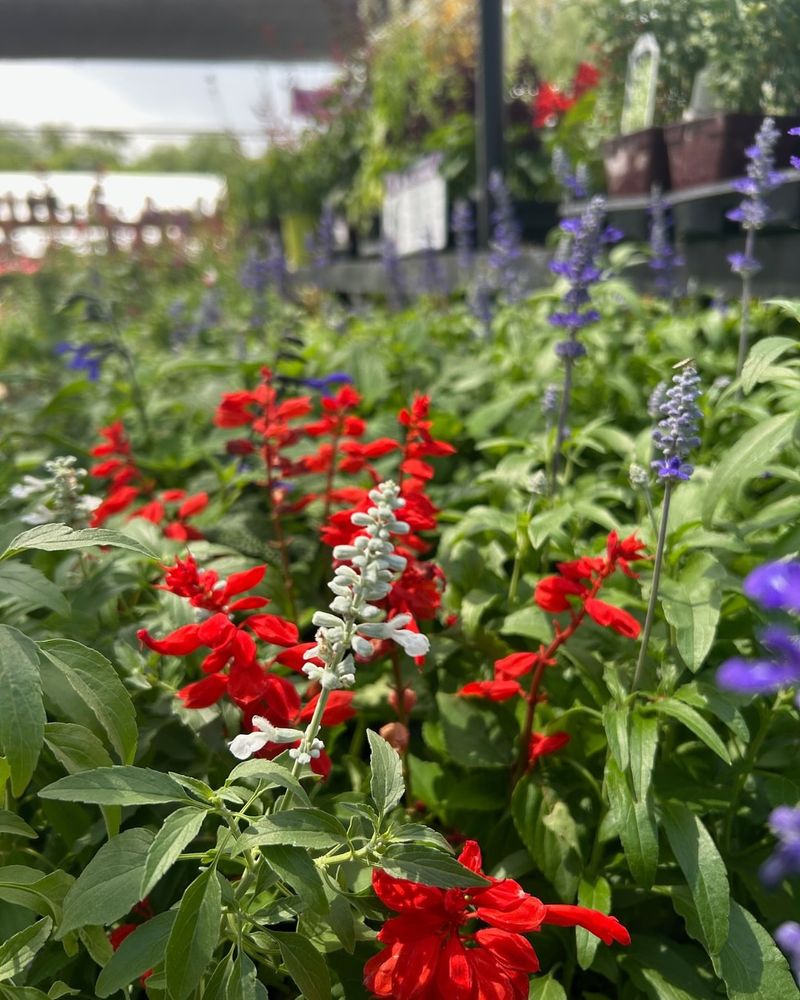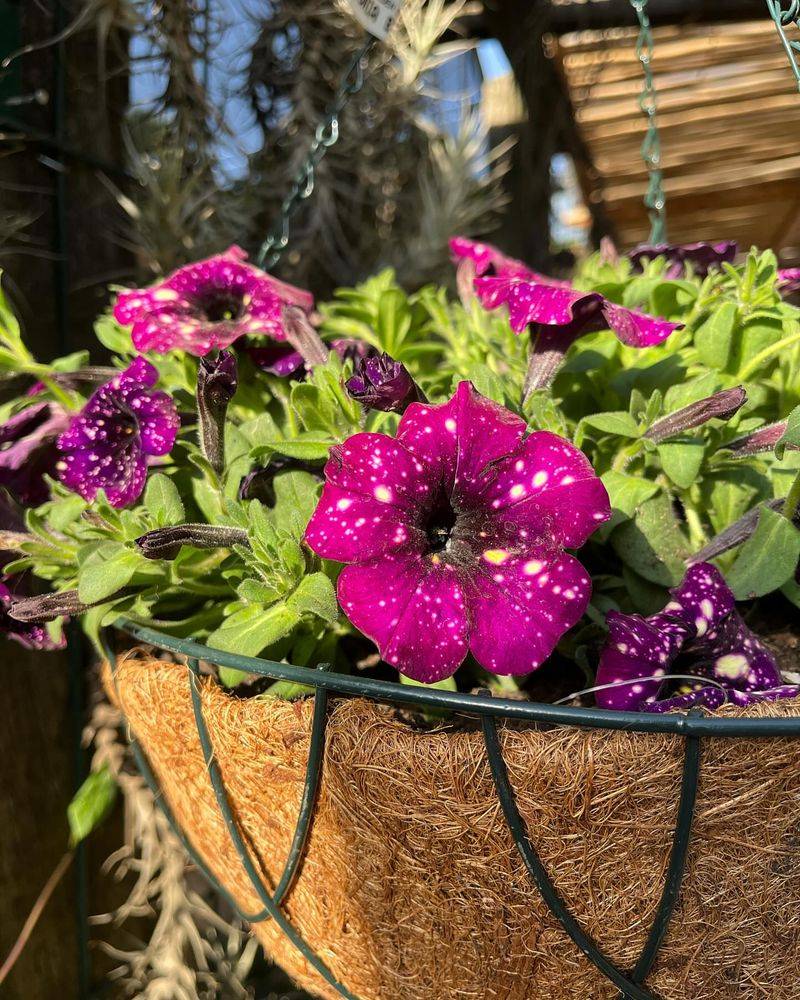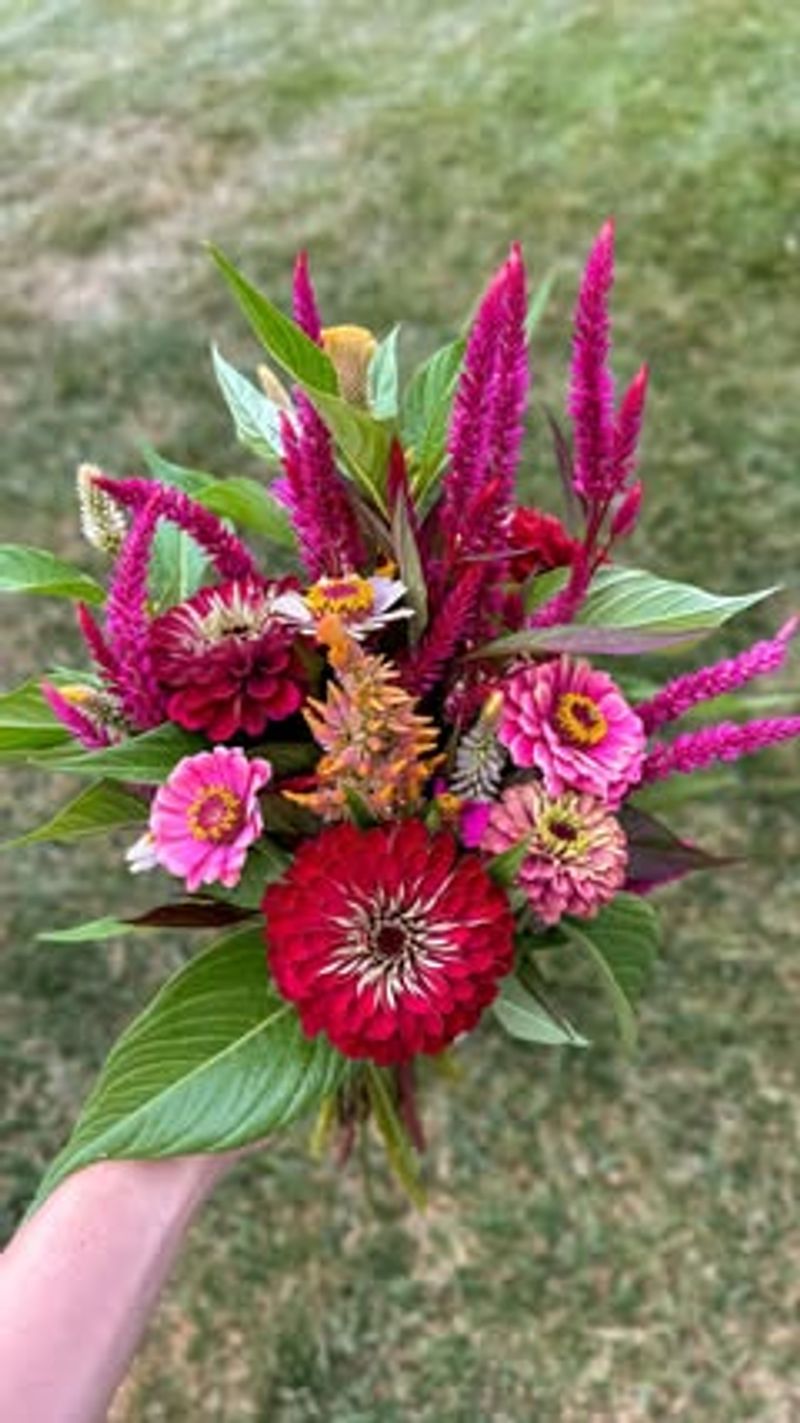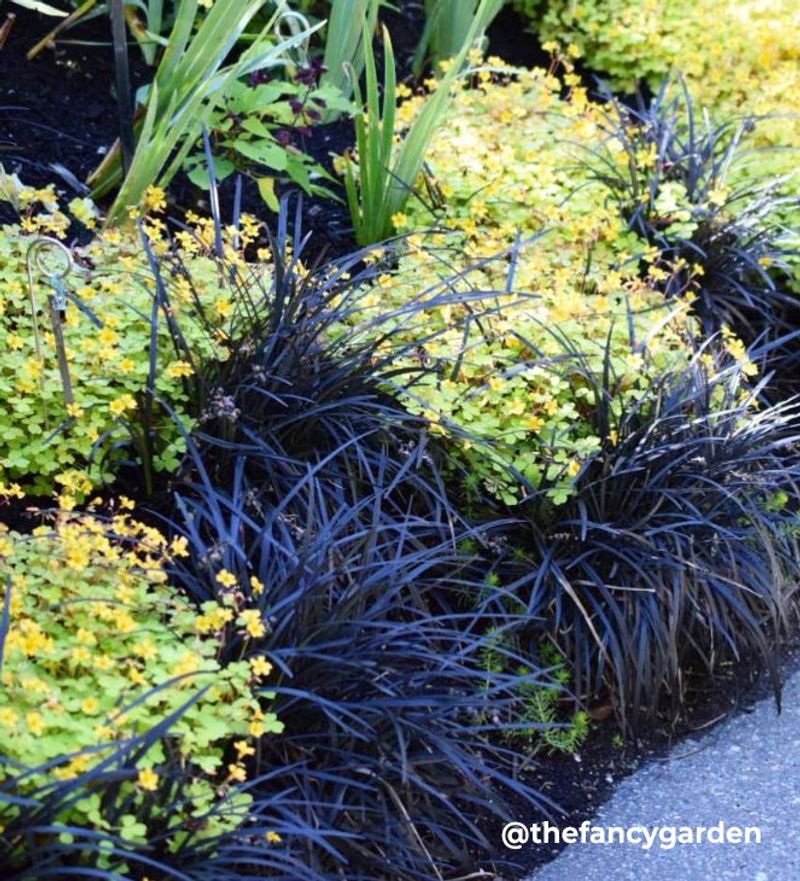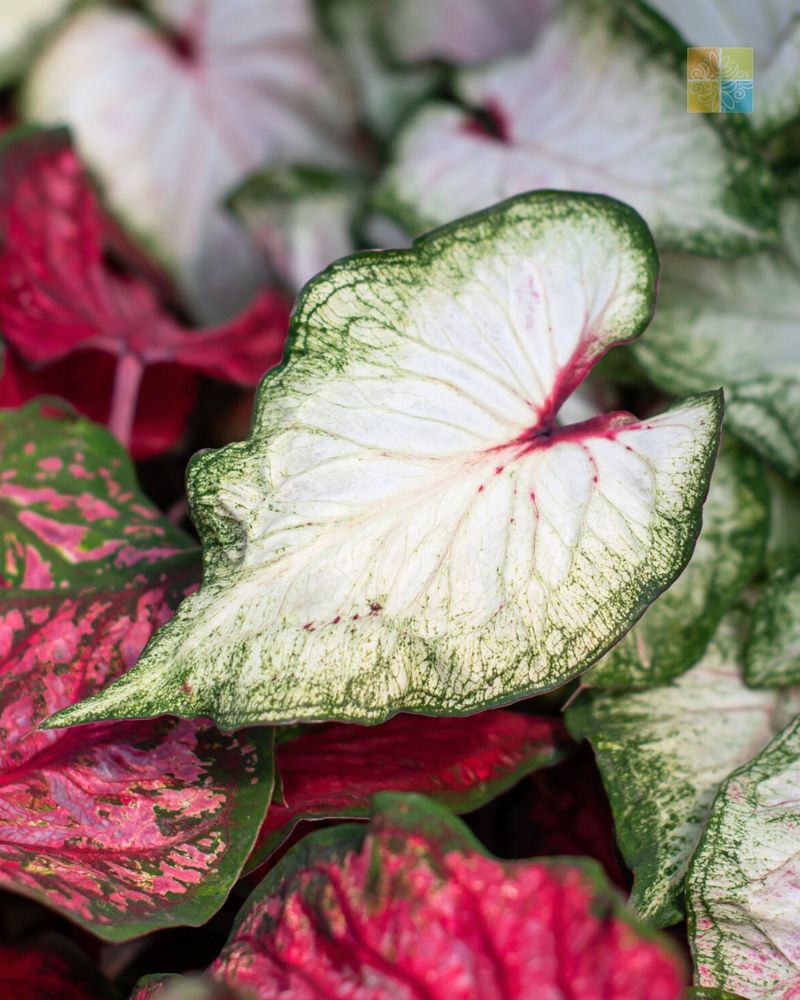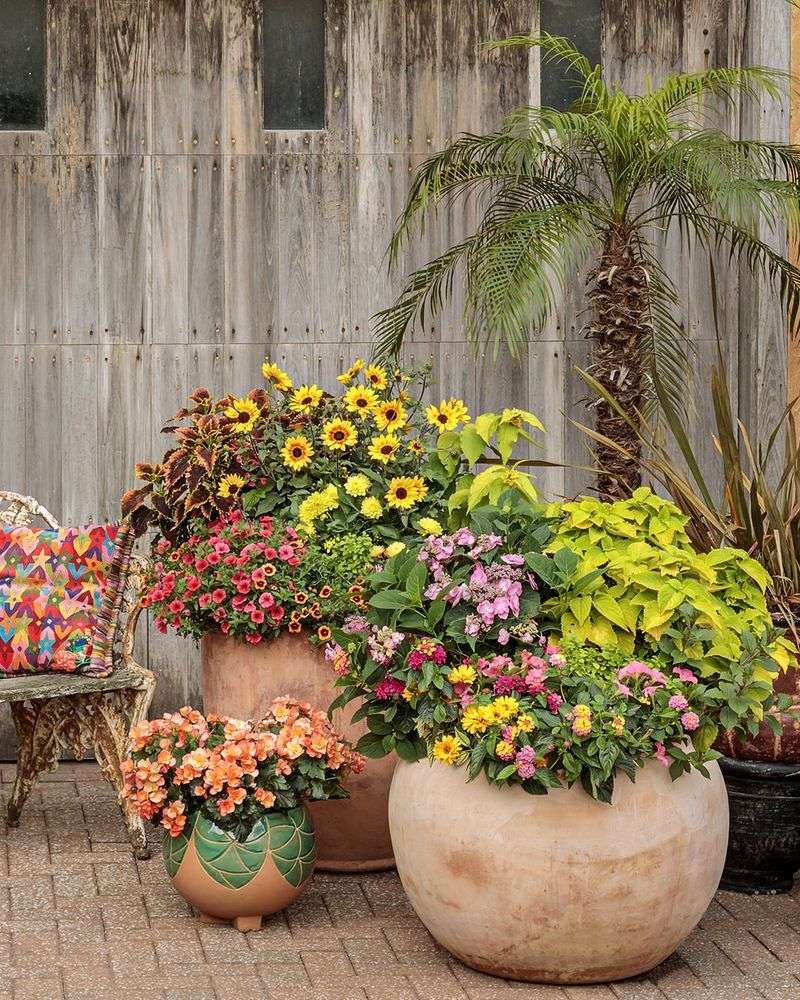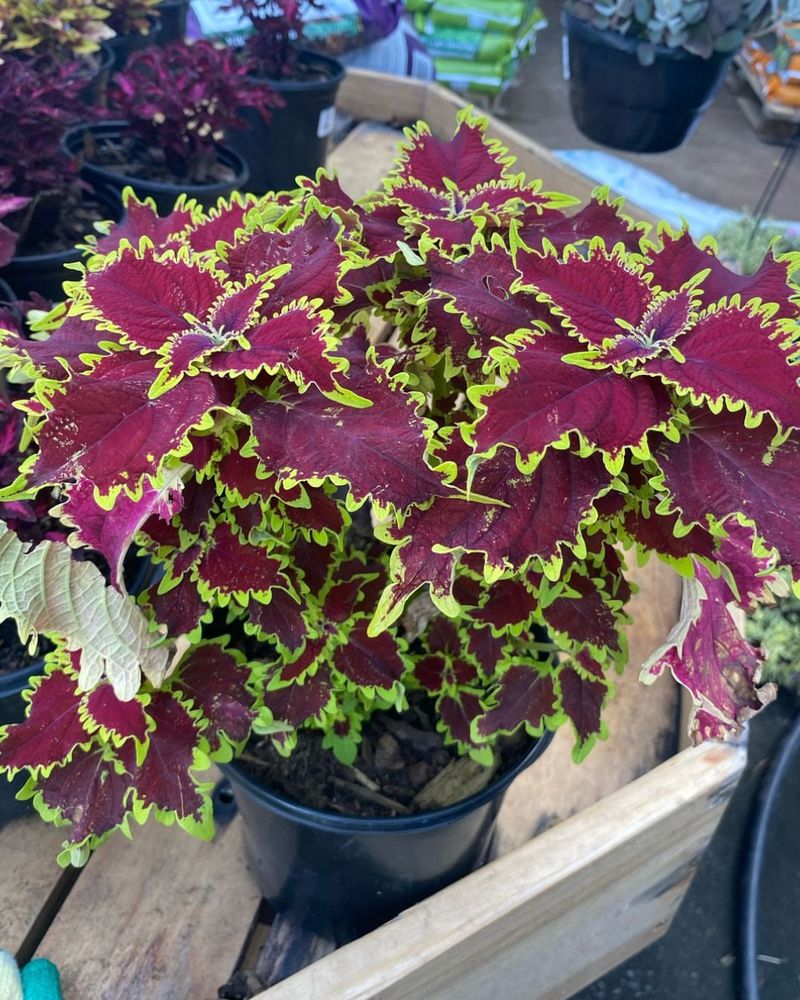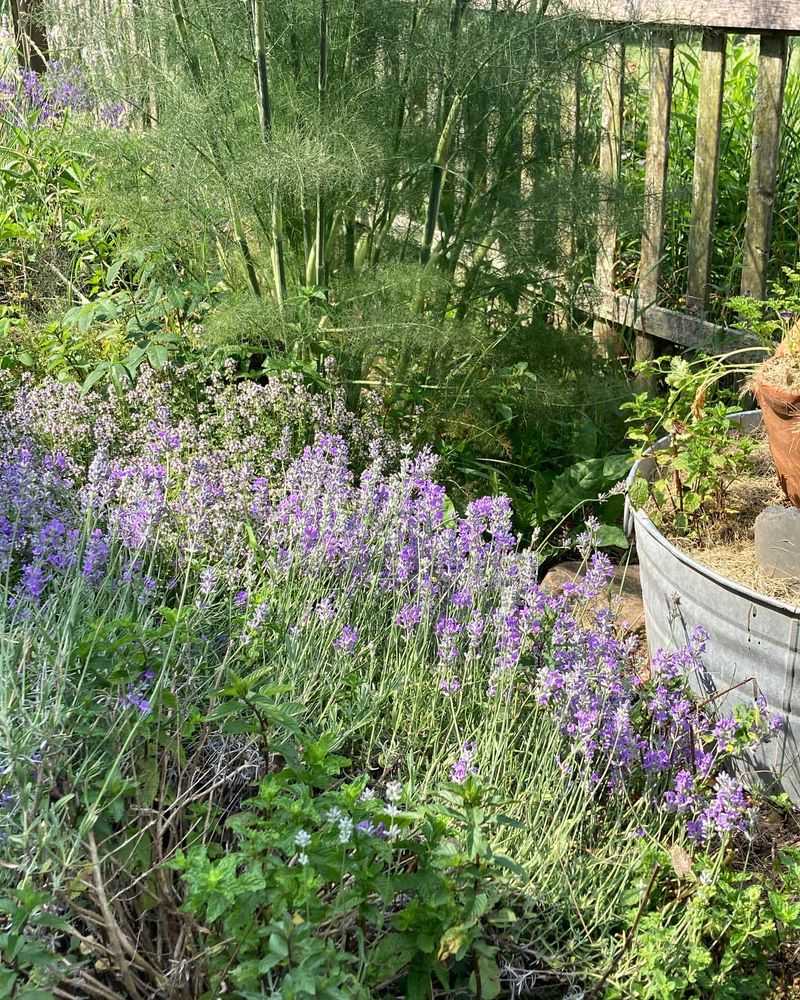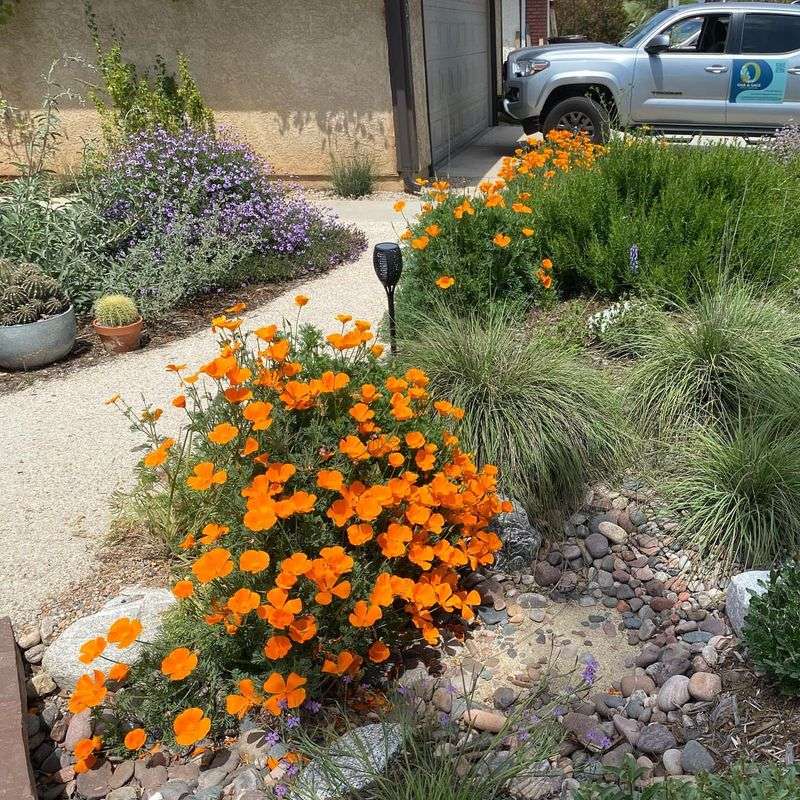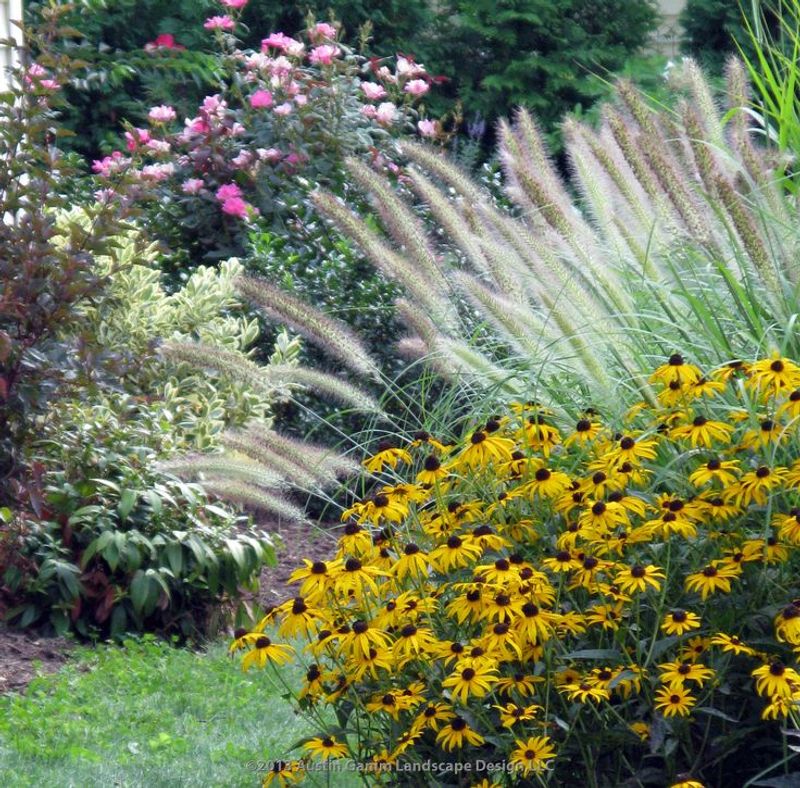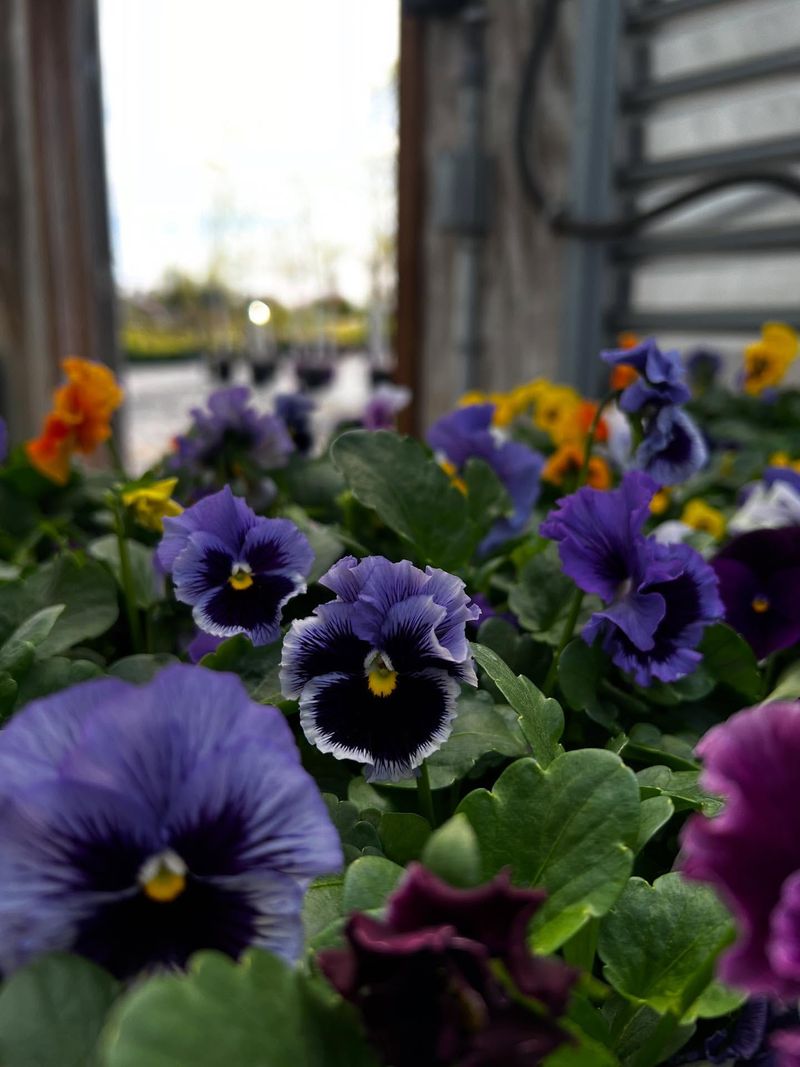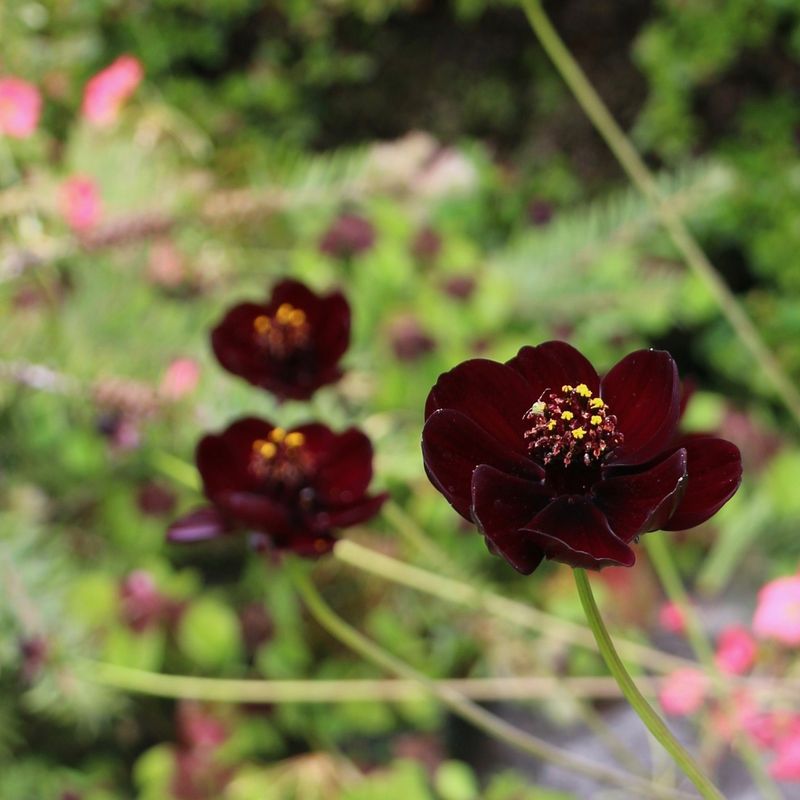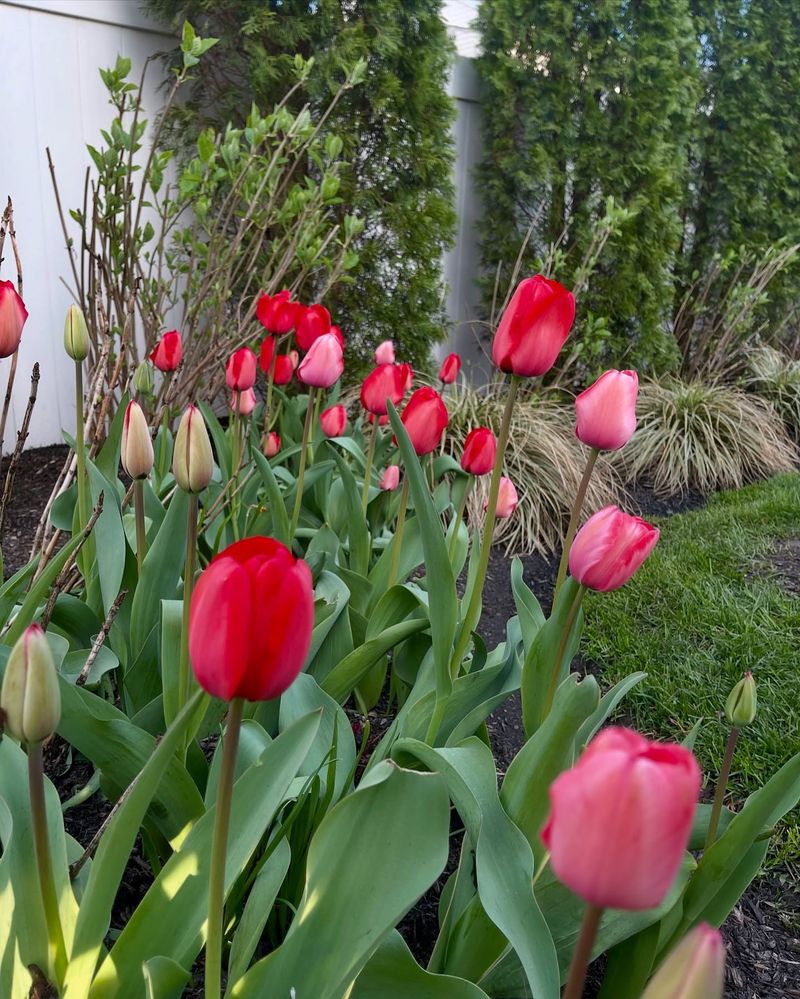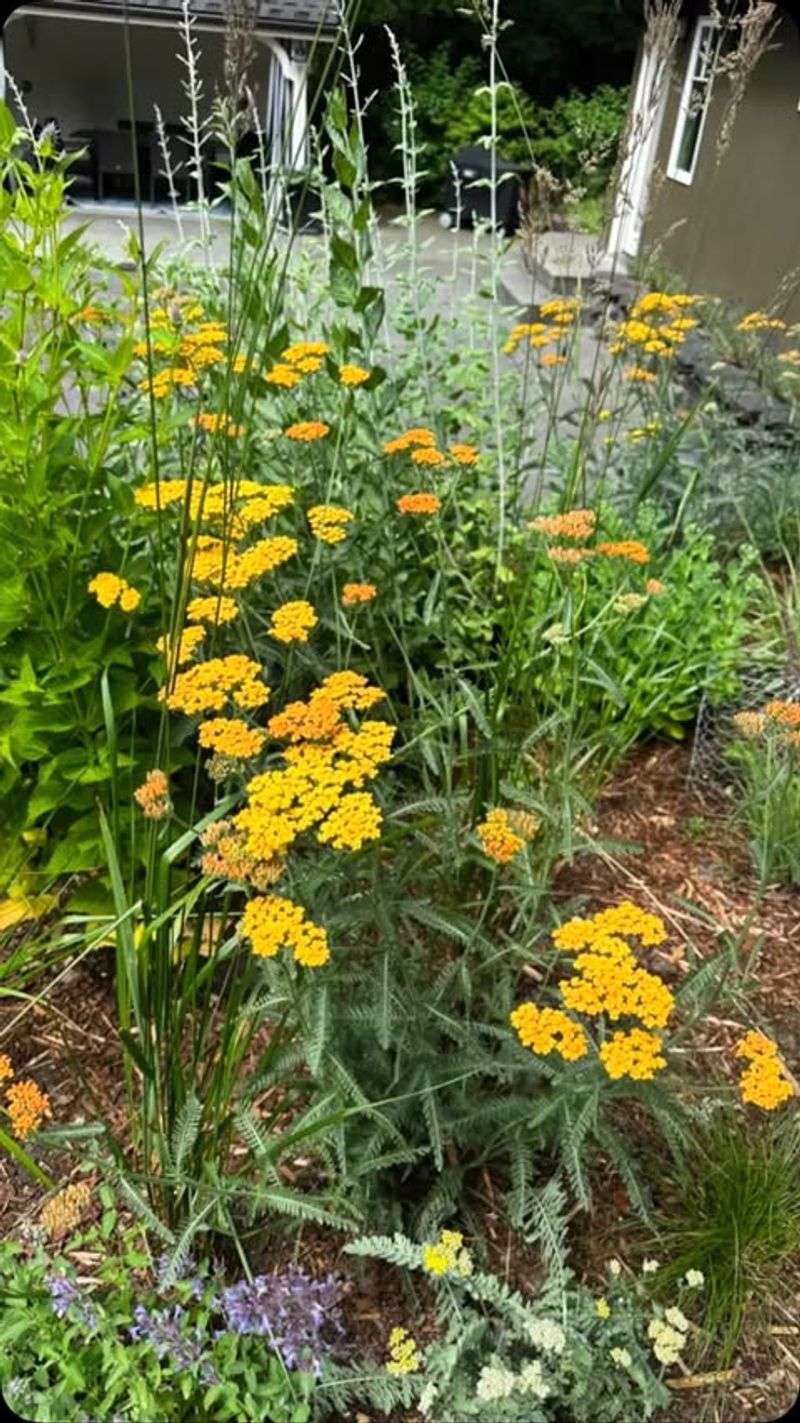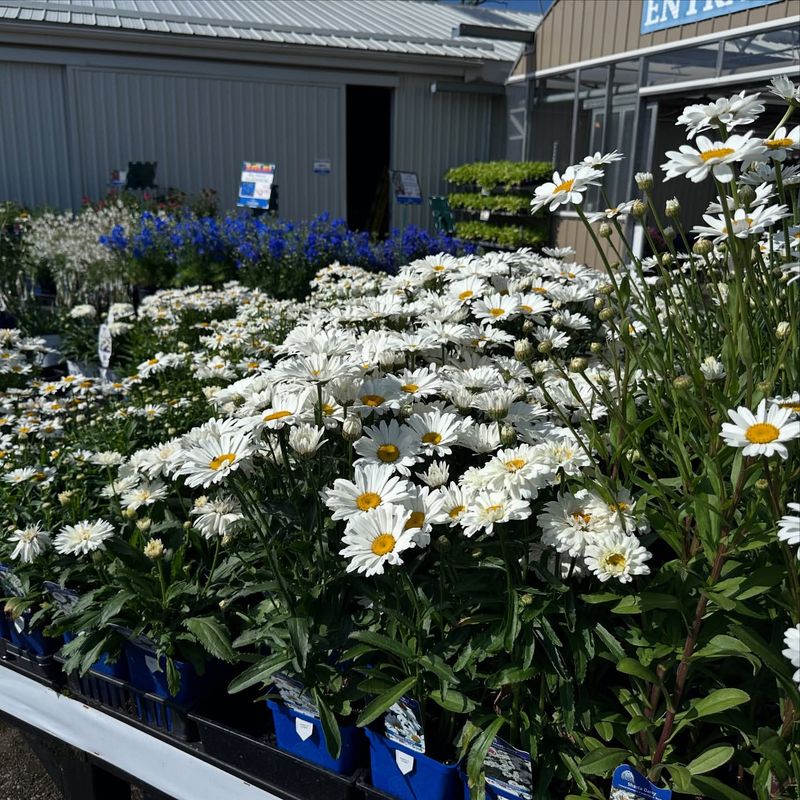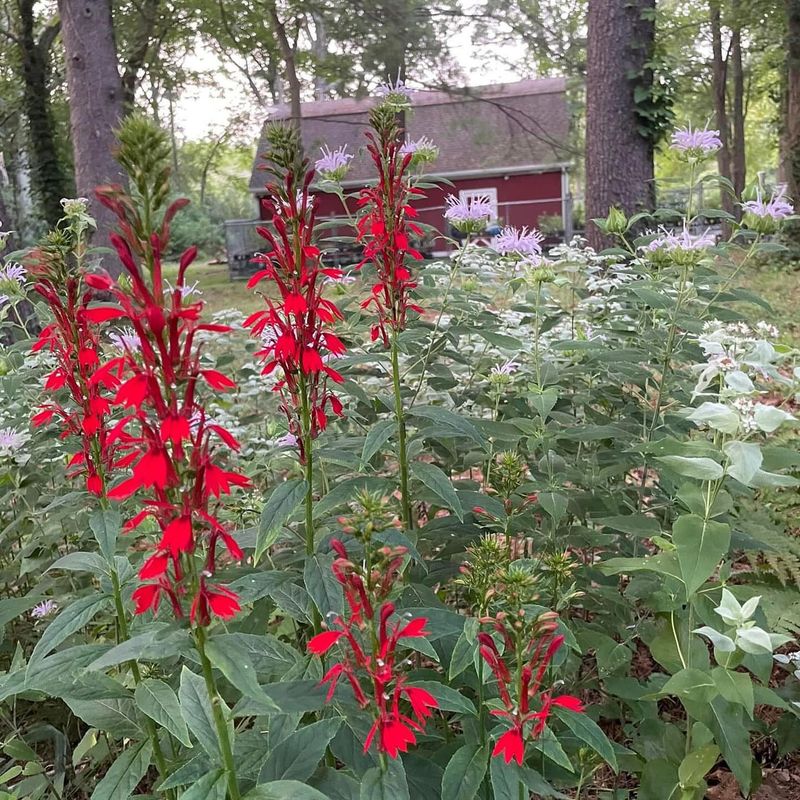Garden design doesn’t have to play it safe. Bold color pairings—fiery reds with moody purples, citrus tones clashing with cool blues—can turn a quiet space into a showstopper.
These unexpected combos aren’t just eye-catching—they’re mood-setters, scene-stealers, and conversation starters rooted in fearless design.
1. Purple Salvia with Bright Yellow Coreopsis
The deep purple spikes of salvia create magical contrast against the sunny yellow blooms of coreopsis. Together they form a vibrant display that mimics colors found in spectacular sunsets.
Plant these perennials in full sun areas where they’ll thrive for years. The vertical growth of salvia paired with the rounded coreopsis flowers adds interesting texture differences beyond just color contrast.
Both plants attract butterflies and hummingbirds, bringing extra life and movement to your garden space while requiring minimal maintenance.
2. Fiery Red Crocosmia with Cobalt Blue Delphinium
Red crocosmia’s flame-like blooms seem to dance when planted alongside towering cobalt blue delphiniums. This combination creates a temperature contrast—hot meets cool—that energizes any garden space.
The sword-shaped leaves of crocosmia provide interesting texture even when not flowering. Meanwhile, the tall spires of delphinium add dramatic height that draws the eye upward.
For best results, position this pairing where it receives morning sun but afternoon shade in hotter climates, as delphiniums can struggle in intense heat.
3. Orange Marigolds with Electric Blue Lobelia
Marigolds bring punchy orange tones that pop against the electric blue of trailing lobelia. This unexpected pairing creates a modern, vibrant look that works beautifully in containers or border edges.
The rounded, full blooms of marigolds contrast wonderfully with lobelia’s delicate, star-shaped flowers. While marigolds stand upright, lobelia cascades downward, creating movement in your garden design.
As a bonus, marigolds naturally repel many garden pests with their distinctive scent, while lobelia attracts beneficial pollinators to your garden ecosystem.
4. Lime Green Nicotiana with Magenta Petunias
Lime green nicotiana (flowering tobacco) creates an almost neon backdrop that makes magenta petunias look even more vibrant.
The color combination feels fresh, modern and slightly tropical. Evening gardeners particularly appreciate this pairing because nicotiana releases a sweet fragrance after sunset. The trumpet-shaped flowers of both plants create a unified look despite their dramatically different colors.
Try this combo in hanging baskets or window boxes where you can enjoy their complementary colors up close and benefit from the delightful scent on summer evenings.
5. Silver Artemisia with Deep Purple Heuchera
Silver-leaved artemisia creates a stunning backdrop for the deep purple foliage of heuchera (coral bells). This combination works entirely on leaf color rather than flowers, providing year-round interest in the garden.
The fuzzy, feathery texture of artemisia contrasts beautifully with the smooth, rounded leaves of heuchera. Both plants thrive in partial shade, making them perfect partners for those trickier garden spots.
During evening hours, the silver foliage seems to glow in moonlight, adding an enchanting dimension to your garden when most flower colors have faded into darkness.
6. Hot Pink Zinnias with Burnt Orange Celosia
Hot pink zinnias paired with the flame-like plumes of burnt orange celosia create a festive, almost tropical vibe.
Their bold personalities complement rather than compete with each other. Both flowers love heat and sunshine, making them reliable performers even during the hottest summer days when other plants might struggle.
Their similar height means neither overshadows the other, creating a balanced visual partnership. Cut some stems for indoor arrangements—both varieties are excellent long-lasting cut flowers that will bring this dramatic color story inside your home.
7. Black Mondo Grass with Golden Japanese Forest Grass
The nearly black blades of mondo grass create jaw-dropping contrast next to the bright golden waves of Japanese forest grass (Hakonechloa).
Their dramatically different colors make even a small planting look like a professional landscape design. Both grasses maintain their distinctive colors throughout the growing season, providing reliable visual impact.
The arching habit of the forest grass softens the more upright mondo grass, creating a beautiful textural relationship. Plant this combination in dappled shade where the golden tones will appear to glow against the dark backdrop.
8. White Caladium with Scarlet Begonia
White caladium leaves with their green veining create a sophisticated backdrop for the brilliant scarlet flowers of begonias. This combination thrives in shady spots where many colorful plants struggle.
The large, heart-shaped leaves of caladium add tropical drama and take up visual space, while the smaller begonia flowers provide pops of intense color.
Both plants appreciate similar soil conditions and watering schedules, making them compatible companions. For extra impact, choose begonia varieties with dark burgundy leaves to add another layer of color contrast against the white caladium.
9. Chartreuse Sweet Potato Vine with Purple Verbena
Chartreuse sweet potato vine creates electric contrast against deep purple verbena flowers. The sprawling vine acts as a living mulch beneath the more upright verbena, filling every inch with bold color.
This pairing works exceptionally well in containers where the sweet potato vine can cascade over edges while verbena provides height in the center. Both plants handle heat well and continue looking fresh even during summer’s most challenging days.
The rapid growth of sweet potato vine means this combination quickly reaches its full dramatic potential, perfect for gardeners seeking instant impact.
10. Burgundy Coleus with Lime Green Sweet Alyssum
Deep burgundy coleus foliage creates a rich backdrop for the frothy, lime-green flowers of sweet alyssum. The color intensity of coleus makes the delicate alyssum appear even more vibrant and fresh.
Fragrant alyssum attracts beneficial insects while spreading to form a living carpet at the feet of the more architectural coleus.
Their contrasting textures—bold and delicate—add another dimension beyond just color differences. This combination works beautifully in both containers and garden beds, providing continuous color even when other plants aren’t blooming.
11. Copper Fennel with Lavender Flowers
Bronze fennel’s coppery, feathery foliage creates an airy backdrop that makes lavender’s purple flower spikes appear to float. This combination brings together contrasting colors, textures, and even fragrances.
Both plants attract beneficial insects to your garden, with the fennel specifically serving as a host plant for swallowtail butterflies. They share similar growing requirements, preferring full sun and well-drained soil.
The copper and purple palette has a sophisticated, almost metallic quality that changes throughout the day as light shifts across the garden.
12. Blue Fescue Grass with Orange California Poppies
Blue fescue’s silver-blue tufts create a cool-toned base that makes orange California poppies appear even more vivid. This combination follows the classic blue-orange color wheel opposition that designers love.
Drought tolerance makes this pairing practical for water-conscious gardens or challenging spots with poor soil. The rounded shape of fescue contrasts beautifully with the delicate, cup-shaped poppy blooms.
Allow poppies to self-seed around the more permanent fescue clumps for a naturalistic look that improves each year with minimal maintenance required.
13. Pink Muhly Grass with Yellow Black-Eyed Susans
Pink muhly grass creates clouds of rosy plumes in late summer that look magical when surrounded by the golden yellow of black-eyed Susans. The combination feels both wildly natural and carefully designed.
Morning or evening light filtering through the pink grass creates a glowing effect that photographers love to capture. Both plants attract different wildlife—birds come for grass seeds while bees and butterflies visit the black-eyed Susans.
Plant in large sweeps rather than single specimens to maximize the dramatic color impact across your landscape.
14. Ruby Red Swiss Chard with Blue Pansies
Ruby-stemmed Swiss chard with its glossy leaves creates an unexpected but stunning contrast when paired with cool blue pansies. This combination beautifully bridges the gap between ornamental and edible gardening.
The substantial, upright form of chard provides structure while the smaller pansies create a colorful carpet below. Both plants tolerate cooler temperatures, making this pairing perfect for spring and fall gardens.
Harvest chard leaves regularly from the outside of the plant to maintain its attractive appearance while enjoying its nutritional benefits in your kitchen.
15. Peachy Coral Roses with Purple Catmint
Coral roses gain extra visual impact when surrounded by the soft lavender-blue cloud of catmint blooms. The warm peachy tones seem to glow against the cooler purple background.
Catmint’s aromatic foliage naturally repels many garden pests while attracting beneficial pollinators. Its sprawling habit softens the more formal structure of rose bushes, creating a pleasing balance between wildness and order.
For maximum drama, choose coral roses with a slight color shift from bud to bloom, creating a multi-toned effect against the consistent purple of the catmint.
16. Chocolate Cosmos with Pale Pink Gaura
The deep maroon-brown flowers of chocolate cosmos create sophisticated contrast against the dancing pale pink blooms of gaura. Their color relationship feels both unexpected and perfectly harmonious.
Both plants feature movement in the garden—cosmos nod gently while gaura’s butterfly-like flowers seem to hover on wiry stems. They share similar growing requirements, thriving in full sun and well-drained soil.
As a bonus, chocolate cosmos actually smell like chocolate, adding a sensory dimension beyond just visual impact when visitors brush against the plants.
17. Emerald Green Boxwood with Red Tulips
Formal boxwood hedges in rich emerald green create a structured framework that makes scarlet red tulips look even more dramatic in spring. The combination balances permanence with seasonal excitement.
Boxwood provides year-round structure and color while tulips deliver seasonal punch. The smooth, glossy texture of boxwood leaves contrasts beautifully with the silky petals of tulips.
After tulips finish blooming, replace them with red annual flowers like geraniums or salvias to maintain the color story throughout the growing season.
18. Silvery Blue Sea Holly with Golden Yarrow
Spiky, metallic blue sea holly (Eryngium) creates spectacular contrast against the flat-topped golden flowers of yarrow. Their dramatically different forms and colors create a partnership that demands attention.
Both plants attract beneficial insects and butterflies while tolerating drought conditions once established. The silvery stems of sea holly seem to shimmer in the sunlight, adding another dimension to this already dramatic pairing.
Try this combination in a gravel garden or dry border where their drought tolerance becomes a practical advantage and their architectural qualities stand out clearly.
19. Dark Blue Gentian with Bright White Shasta Daisies
Deep blue gentian flowers create striking contrast against pure white Shasta daisies. The intensity of the gentian blue seems even more vivid when paired with crisp white.
Both plants bloom during mid-summer when many spring flowers have faded. Their similar heights create a balanced, harmonious look rather than a layered effect, making them perfect companions in a border.
For maximum impact, plant in groups of at least five of each variety to create blocks of color rather than scattered individual plants.
20. Bright Red Cardinal Flower with Yellow Rudbeckia
Cardinal flower’s brilliant red spikes rise dramatically through a sea of golden yellow rudbeckia (black-eyed Susans). This combination mirrors colors found in flames, bringing natural warmth to garden borders.
Cardinal flowers attract hummingbirds while rudbeckia brings in butterflies, creating a wildlife-friendly planting. Both enjoy similar light conditions but cardinal flower appreciates more moisture, so place it in the lower, damper section of your garden.
The vertical growth of cardinal flower contrasts beautifully with the more rounded form of rudbeckia, creating visual interest beyond just color.

